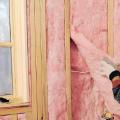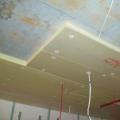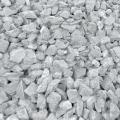Insulation of aerated concrete house with polystyrene foam, polyurethane foam, mineral wool
Expanding the topic of this article, it is necessary first of all to answer the question of what aerated concrete is. Well, first of all, it is a building material. Secondly, it belongs to the category of cellular concrete, as a result of which a porous structure saturated with gas bubbles is formed inside the material.
Accordingly, the quality of this material will largely depend on the uniform distribution of pores, their density and closedness.
Pay attention!
In principle, this is a natural material that is made from quartz sand and cement with the addition of special gas-forming agents.
Most often, their role is performed by aluminum powder.
Technologies for the production of aerated concrete are different, hence the recipe, which varies depending on the type of technological process. For example, manufacturers often add lime to the composition of aerated concrete, less often gypsum.
The production technology is quite simple.
- All components are mixed in certain proportions.
- Molding occurs, where the material begins to expand under the influence of a chemical reaction, during which gas formation occurs.
- After preliminary drying, the aerated concrete is cut into blocks.
- Then the finished product must be dried. There are two methods: autoclave and non-autoclave.

Attention!
When using the first method, the strength characteristics of the material increase, but at the same time its price becomes higher.
Please pay attention to one very important point that relates to the topic of our article. The porous structure of aerated concrete suggests that this material itself is a good heat insulator. True, there is one “BUT” here. By increasing the thermal insulation qualities of aerated concrete, we reduce its strength properties.
That is, the more pores inside the product, the weaker it is, but the higher the insulation performance. Therefore, the question of whether or not to insulate a house built from aerated concrete blocks will largely depend on the brand of the product. And if you purchase more porous blocks, then remember, you should not build multi-story buildings from them.
Now let's move on to the process itself and from the inside.
Is it necessary to insulate
We partially answered the question of whether it is necessary to insulate a house made of aerated concrete. But it is necessary to focus on another aspect. Aerated concrete blocks have high vapor permeability, that is, they “breathe” very well. This seems to be a big plus, but on the other hand it is also a minus.

Attention!
Walls made of aerated concrete blocks must be constructed in such a way that the vapor permeability of the material decreases from the outer surface of the wall to the inner one.
That is, the question of how to properly insulate the walls of a house made of aerated concrete is solved in exactly this way.
If everything turns out the other way around, then the gas inside the pores will begin to gain moisture, which will negatively affect the strength of the material, and, accordingly, the entire structure of the building as a whole.
To prevent the penetration of wet vapors into the body of the blocks, it is necessary to insulate the walls both outside and inside. Therefore, first of all, we will analyze several basic thermal insulation materials that are currently most often used in this process.
Let's figure out how to insulate aerated concrete walls.
Insulation materials
The modern building materials market is now ready to offer a huge range of thermal insulation materials that can be used to insulate aerated concrete.
Expanded polystyrene and polyurethane foam
Experts today give preference to such heat insulators as:
- expanded polystyrene (regular and extruded);
- polyurethane foam.

- The first insulation has a different structure relative to the density of the material itself. For example, ordinary polystyrene foam (also known as polystyrene foam) is less durable, less dense, and therefore less reliable. In addition, it does not have high thermal insulation rates.
Extruded polystyrene foam is a dense and durable insulation material with high thermal insulation performance.
- Polyurethane foam is a unique material. Firstly, it is a building mixture that is applied to the walls under pressure. Secondly, when it hits the surface, it instantly bonds with it, creating a reliable foamed protective layer. Thirdly, such insulation will last for several decades.

But there is one very serious point here. Expanded polystyrene is a slab material that is not difficult to lay on the wall with your own hands. But you won’t be able to apply polyurethane foam to the surfaces to be treated yourself.
This requires not only experience and skills, but also special equipment. Therefore, this method of insulation is quite expensive, but effective.
Mineral wool
I would like to say a little about mineral wool. This is one of the most effective thermal insulation materials. But experts note that it is better not to use it with aerated concrete.
The thing is that mineral wool has the property of drawing in moist air vapor, which is a negative factor for aerated concrete blocks (we have already discussed this above).

So, you know which insulation for aerated concrete walls is better, now you can move on to the very process of arranging the thermal protection of the building.
And first of all, we will consider insulating aerated concrete with expanded polystyrene as the most budget option.
Insulation of walls made of aerated concrete blocks
As mentioned above, insulation of aerated concrete walls is carried out from the outside and from the inside. Why on both sides?
Remember!
Humidity and condensation largely depend on the dew point.
Until thermal insulation work is carried out, this point is located on the surface of the wall.
As soon as the insulation process is completed, the dew point will move to the surface of the heat insulator.
A small mistake or incorrect work can lead to condensation forming on the insulation, and this is a guarantee that this material will soon begin to lose its qualities and properties.
As in any construction process, the insulation of aerated concrete houses is divided into several stages.
Stage No. 1
This is the internal insulation of aerated concrete walls.
I would like to note that many of us independently insulated a loggia or balcony, so many technical processes will be familiar, taking into account the specifics of aerated concrete.

- In principle, aerated concrete blocks are a very flat and smooth surface, which makes no sense to process it to perfection. But sometimes they also have defects. Therefore, cracks and chips are sealed with glue or cement mortar, and the bumps are removed with sandpaper or a sharp spatula.
- After which the entire surface must be primed to create high wall adhesion. Please note that in some areas of the house the walls will be negatively affected by humidity.
So, such walls must be treated with waterproofing compounds. And when it all dries (usually this takes up to six hours), you can start plastering. In this case, there is no need to use a thick layer of plaster. - And the last thing is finishing. The easiest way is to paint the walls with special vapor-permeable paints, which are specially made for aerated concrete.
If plasterboard is used as finishing, then the wall must be additionally treated with a primer. By the way, drywall can be glued to such surfaces.
Stage No. 2
This is insulation of the facade of a house made of aerated concrete. Everything is much simpler here because there is no need to mess with dirty processes. Although it should be noted that manufacturers today have begun to offer plaster solutions that are intended specifically for aerated concrete blocks.
Such solutions have excellent vapor-permeable properties, and also never crack.
Attention!
There is one very important point.
If the walls are treated with vapor-permeable materials from the inside and vapor-proof materials from the outside, then the likelihood that there will be increased humidity inside the house is very high.
Therefore, be extremely careful when choosing a heat insulator.
The slab material is laid directly on the wall, for which you can use either a cement-based fastening mortar or special mushroom-shaped screws. In the case of self-tapping screws, experts do not recommend using metal products that will begin to rust after a while.
And the last thing is finishing. What to choose?
In principle, there are a lot of materials, it’s better to note what not to choose.
- Vapor-proof paints;
- Polymer-based solutions;
- Solutions based on foamed plastics;
- Foam glass.
Yes, and do not forget to insulate all elements of the house, otherwise there will be little benefit from the work done. We are talking about insulating plastic windows, entrance doors, basements, roofs, and so on.

Conclusion on the topic
As you can see, the instructions on how to properly insulate a house made of aerated concrete using expanded polystyrene (foam plastic) are not that complicated. Of course, knowing the nuances of this process will ensure simplicity and reliability, but in any case, anyone can cope with such work without problems.
In the video presented in this article you will find additional information on this topic.
 Construction materials and list of works
Construction materials and list of works Proper insulation of a wooden ceiling in a private house
Proper insulation of a wooden ceiling in a private house What types of crushed stone are there?
What types of crushed stone are there?